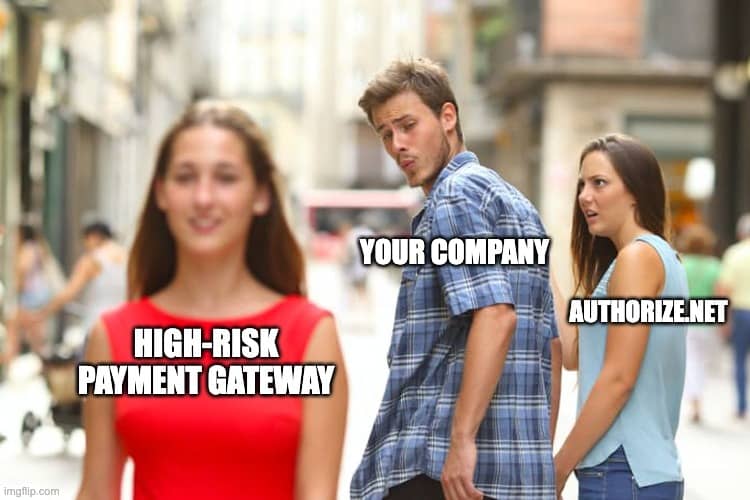Interchange Plus Vs. Flat Rate Fees: What To Know

As any business knows, you will pay many fees for credit card processing. That being said, all fees aren’t created equal, and the fees you ultimately pay are actually made of various parts. These added expenses vary by the card you process. Some of these charges will change based on the purchase amount. Other fees are charged per transaction, and some are a percentage of the overall purchase price.
For the sake of your business, it is vital that you understand these fees and where you may have room to negotiate. This is even more important if you are a high-risk business and have to pay a very high percentage of your overall profits.
What fees will you pay for credit card processing services?
Regardless of what kind of business you run — and if you operate a high-risk industry or not — you will have to pay heavy fees. These charges can get very expensive, very quickly, which helps explain why you need to work to limit them whenever possible.
When you pay fees on a credit card, you will pay at least three types. These include:
- Interchange fee: The fee goes to the issuing bank or financial center that issued the credit card. Countless banks — including the biggest ones in the world — require the payment of Interchange fees. They may fluctuate based on the bank that issues the payment, but they will typically cover the entire interchange cost, plus a bit of profit for the bank in question.
- Assessment fee: This is the fee issued by the credit card company itself, including Mastercard, Discover, Visa, and American Express. Credit card companies have different assessment fees, although all are relatively similar.
- Payment processor fee: This is the portion of the fee that goes to the actual payment processor, including PayPal, Stripe, Square, or Zenti.
The last fee for high-risk businesses can get you the most. The payment processor fee is levied by the company that does the processing work. Therefore, you will pay higher prices if your company is a high-risk business. This means that you have a higher chargeback ratio than most or otherwise have reputational challenges that make these processing companies believe you may be at a higher risk of doing business. That’s why it is important that you find a payment processor — like Zenti — that has experience working with high-risk credit cards and can ensure you get the lowest possible fees.
What types of plans are offered? What are the differences between them?
Here’s where we start understanding the difference between interchange plus and flat rate pricing. Both processing models incorporate interchange fees, assessment fees, and processing fees.
Flat Rate/Blended Pricing
This model might be the easiest to understand of the three models. You pay two fees: A percentage of the fee of a transaction and a flat rate per transaction. The speed you pay varies depending on the industry and what you can negotiate with your payment processor. However, high-risk businesses — like adult services or CBD vendors — will pay a higher percentage than other businesses. This structure means that this pricing model may not be appropriate for all vendors.
This pricing model is easy to understand and predictable. You’ll know your processing rate, understand your processing costs, and always have the same transaction fee. However, it’s also potentially expensive and may not be appropriate for your business.
Tiered Pricing
Life gets a little more interesting with tiered pricing models, which typically offer different tiers of charges based on the credit or debit card you accept. From least expensive to most expensive:
- Qualified cards, including debit cards and credit cards without rewards programs.
- Mid-qualified, which offered limited rewards
- Non-qualified, which are high rewards credit cards or corporate cards.
Merchants pay higher fees on rewards credit cards, as these programs are expensive for credit card companies to operate, and the money to operate them comes from transactions. As such, a small business owner pays lower fees for qualified cards than for non-qualified cards. This model may not work if your business typically does extensive corporate card processing but may work extremely well if you deal primarily with debit cards.
Interchange Pricing
The pricing of interchange rates will vary with every transaction based on a series of factors. This includes:
- If the transaction was completed via a point of sale device or if the transaction was card-not-present.
- The card network is used, as different credit cards charge different rates.
- The type of card used. Like in tiered pricing, rewards cards are more expensive than non-rewards cards.
This structure results in cheaper credit card processing fees for many businesses, which can help keep costs down. However, the greater challenge here is the variability: It can be very difficult to predict your credit card costs.
If you are a business owner, you’ll have to thoroughly review your business model and determine which merchant account plan works best for you. Figuring this out can be complicated, and it also may change over time. As such, you will want to make sure you work with a merchant account provider that can not only give you the plan you need but ensure that you have the flexibility to change plans if your needs change later.
Where can I negotiate?
It is only the payment processor fee that leaves you room to negotiate. The interchange fee and assessment fee are both levied by banks and credit card companies. These don’t change based on negotiations, though they may change the volume of business. However, the payment process fee may be negotiable. This is where companies will mark up their prices to cover their expenses and make a profit. As such, you may be able to get these prices brought down.
However, here’s where being a high-risk business can come into play. First, you will pay higher rates as a high-risk business. These rates are meant to offset the risk that a credit card processor has in working with you, as they may be concerned that they will have to initiate chargebacks or help recover fraudulent charges. This is why you need to work with a vendor who fully understands the difficulties of a high-risk business and can keep these charges to a minimum. Fortunately, Zenti has years of experience dealing with high-risk businesses and knows how to work with you to keep your charges to a minimum.
What can my business do to limit these fees?
Keeping chargebacks to a minimum is critical for your business. Thankfully, there are many ways that you can work with both your merchant account provider and your customers to keep returns to a minimum. These include the following:
- Have appropriate policies that outline when you will accept refunds and how those refunds will be processed.
- Ensure that information about your business and the charge is fully explained in a credit card statement. This can help ensure that your customers know exactly what they are purchasing to prevent an accidental fraud claim.
- Be transparent with what your customers are buying and ensure they know the refund procedures.
- If you operate with a subscription-based or recurring model, send reminders to your customers, allowing them to cancel a payment before it is made. This reminder will potentially save you a chargeback fee.
- If a customer does seek a refund, try to give them an alternative to a refund, like a gift certificate.
- Ensure that your website is as secure as possible using the latest security measures. Keeping your website as secure as possible can help reduce unauthorized charges and stop chargebacks and customer fraud.
- If possible, send an Email to a customer upon the completion of a transaction. This Email can be great for their records and your records. The Email can also lay out refund procedures.
Above all else, make sure you work with a high-quality merchant account processor that can help you determine what your business needs to do to reduce these fees and assist you in the creation of a chargeback-reduction plan. This can keep your fees low and help to ensure that your customers are happy.
What if I operate a high-risk business?
High-risk businesses have different needs than low-risk businesses. If you operate a high-risk business, you will need to develop a variety of specific tools that can help you not only take credit card and debit card payments at an affordable rate but ensure that you can ultimately reduce your expenses.
Some businesses — specifically those that have reputational issues — will constantly be challenged to leave the high-risk tier. Others can leave it if they work to reduce expenses. However, operating a high-risk business means more than higher fees. It may take more time to get approved for merchant account services. You’ll have to fill out additional paperwork and provide information like bank statements and credit card history. This can be highly challenging to a busy business.
Furthermore, you may also have specific needs that are different than other businesses. As such, you’ll need to find a merchant account provider with experience in dealing with high-risk businesses and who knows how to help you meet these needs. They include:
- Managing offshore accounts: Some businesses may take charges from foreign entities. This is typically a higher-risk service, as odds of fraud are greater when charging an offshore account.
- eCheck processing: Many businesses — including those with high-risk merchants — will do business via eCheck processing. This is a specific type of merchant account processing service that operates very differently than processing a standard credit card. Again, this may not be appropriate for all businesses, like those who deal primarily with retail services, but it may work for many internet-based companies.
- ACH processing: ACH stands for Automated Clearing House, and it’s a type of transaction that occurs when a business “sweeps” a bank account for payment. This is common with many subscription-based businesses, and having the right kind of ACH processing that can keep fees to a limit is critical for many companies.
- Cryptocurrency processing: This payment method was barely heard of a few years ago but has become exceptionally popular late. Crypto requires its payment processing software and equipment. For many industries, crypto payment has become very easy and famous, as it can help protect purchasers’ privacy and ensure that all records are kept anonymous. This anonymity makes it perfect for specific industries, like adult services.
- Retail merchant services: Any brick-and-mortar business will need retail merchant services. A business will need access to POS devices that will enable them to process a credit card or debit card in person. It also means that the company will need access to tech support and predictable and easy-to-understand fees levied for these devices’ operation.
- EBT merchant services: Depending on the type of business you operate, you may find it beneficial to be able to take EBT payments. However, this is a highly-regulated field, so you must work with an expert who understands how EBT payments work and what types of goods qualify for EBT.
As you can see, your high-risk business may struggle to find merchant processing services that are affordable and accessible. First, however, you need to find a pricing model that works for your business, including those that keep processing fees low, maintain their markup to a minimum, and have experience working with a small business like yours. That’s Zenti. At Zenti, we have decades of experience working with small businesses and can help you process any card and develop a pricing plan that fits your needs.
Want more information? Contact us today, and learn more about how Zenti can help your business grow.
Read Next

Find out whether Authorize.Net works for high risk merchants, what restrictions you might face and how to get approved.

Get expert advice on selling CBD products on Shopify, including compliance tips and setting up secure payment options.

Find out why Square may deactivate merchant accounts and steps to resolve issues and maintain uninterrupted payment services.
Need a High-Risk Merchant Account?
Disruption-free payment processing at the best price for your situation, guaranteed.
Get Free Guidance Now!